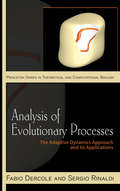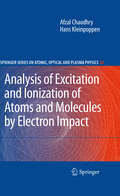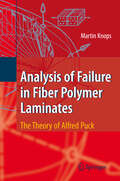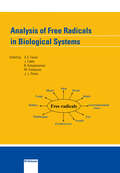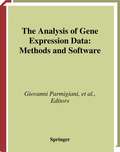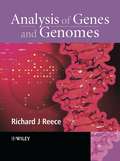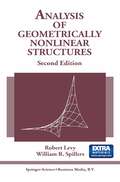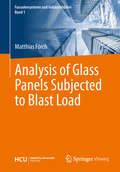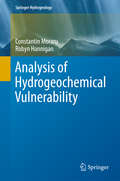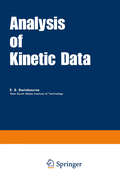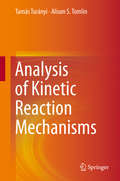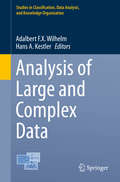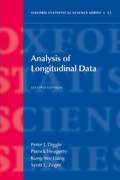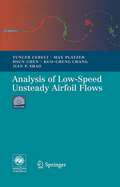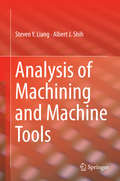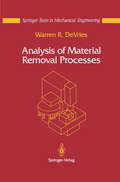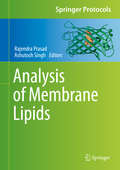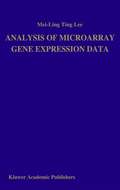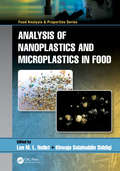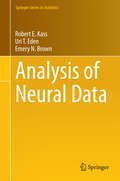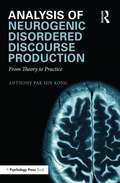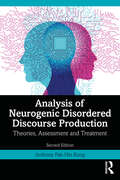- Table View
- List View
Analysis of Evolutionary Processes: The Adaptive Dynamics Approach and Its Applications (PDF)
by Fabio Dercole Sergio RinaldiQuantitative approaches to evolutionary biology traditionally consider evolutionary change in isolation from an important pressure in natural selection: the demography of coevolving populations. In Analysis of Evolutionary Processes, Fabio Dercole and Sergio Rinaldi have written the first comprehensive book on Adaptive Dynamics (AD), a quantitative modeling approach that explicitly links evolutionary changes to demographic ones. The book shows how the so-called AD canonical equation can answer questions of paramount interest in biology, engineering, and the social sciences, especially economics. After introducing the basics of evolutionary processes and classifying available modeling approaches, Dercole and Rinaldi give a detailed presentation of the derivation of the AD canonical equation, an ordinary differential equation that focuses on evolutionary processes driven by rare and small innovations. The authors then look at important features of evolutionary dynamics as viewed through the lens of AD. They present their discovery of the first chaotic evolutionary attractor, which calls into question the common view that coevolution produces exquisitely harmonious adaptations between species. And, opening up potential new lines of research by providing the first application of AD to economics, they show how AD can explain the emergence of technological variety. Analysis of Evolutionary Processes will interest anyone looking for a self-contained treatment of AD for self-study or teaching, including graduate students and researchers in mathematical and theoretical biology, applied mathematics, and theoretical economics.
Analysis of Excitation and Ionization of Atoms and Molecules by Electron Impact (Springer Series on Atomic, Optical, and Plasma Physics #60)
by Afzal Chaudhry Hans KleinpoppenThe content of this book describes in detail the results of the present measurements of the partial and total doubly differential cross sections for the multiple-ionization of rare gas atoms by electron impact. These measurements show, beside other trends, the role of Auger transitions in the production of multiply ionized atoms in the region where the incident electron energy is sufficient to produce inner shell ionization. Other processes like Coster-Kronig transitions and shake off also contribute towards increasing the charge of the ions. The incident electron having energy of 6 keV, for example, in a collision with xenon atom can remove up to nine electrons! (*) X-ray-ion coincidence spectroscopy of the electron xenon atom collisions is also described. The present measurements of doubly differential cross sections for the dissociative and non-dissociative ionization of hydrogen, sulfur dioxide and sulfur hexa fluoride molecular gases by electron impact are also described in the text of this book. The results of the measurements for sulfur dioxide molecule show how this major atmospheric pollutant can be removed from the atmosphere by electron impact dissociation of this molecule. The present results of the measurements for sulfur hexa fluoride give an insight into the dissociation properties of this molecular gas, which is being so widely used as a gaseous insulator in the electrical circuits. The book also describes the present measurements of the polarization parameters of the fluorescence radiation emitted by the electron-impact-excited atoms of sodium and potassium. In these investigations the target atoms are polarized, therefore, the measurements of the polarization parameters give information about the electron atom interaction in terms of the interference, direct and exchange interaction channels.
Analysis of Failure in Fiber Polymer Laminates: The Theory of Alfred Puck
by Martin KnopsWritten by Puck's pupil and appointed successor Martin Knops, this book presents Alfred Puck´s failure model, which, among several other theories, predicts fracture limits best and describes the failure phenomena in FRP most realistically – as confirmed within the "World-wide Failure Exercise". Using Puck´s model the composite engineer can follow the gradual failure process in a laminate and deduce from the results of the analysis how to improve the laminate design.
Analysis of Free Radicals in Biological Systems
by J. L. Pierre A. Favier J. Cadet B. Kalyanaraman M. Fontecave"Oxidative stress" is used as the generic term describing the involve ment of reactive oxygen species in various human diseases. The scope of such a topic is becoming increasingly wide. The recent interest in radicals such as nitric oxide and the discovery of new mechanisms such as the effect of free radicals on redox sensitive proteins and genes are enlarging our understanding of the physiological role of free radicals. Oxidative stress is involved in numerous pathological. processes such as ageing, respiratory or cardiovascular diseases, cancer, neurological pathologies such as dementia or Parkinson's disease. It still remains difficult, however, to demonstrate by chemical measurement the in vivo production of free radicals and even more to realise their speciation. Therefore, the development of new tools and indicators is engrossing many researchers working in this field. Reliable indicators are abso lutely necessary not only to monitor the evolution of oxidative stress in patients but also to evaluate the efficiency of new antioxidant treat ments. The French Free radical club of Grenoble, the CERLIB has been involved for many years in the organisation of international training programs on methodology, in order to provide both theoretical and practical help to researchers from various countries. Such training sessions have been highly successful and participants value the oppor tunity to learn reliable techniques. This positive echo explains why the researchers of CERLIB decided, with the help of Prof. Dr. B. Kalyanaraman, to publish selected techniques on free radical re search.
The Analysis of Gene Expression Data: Methods and Software (Statistics for Biology and Health)
by Giovanni Parmigiani Elizabeth S. Garett Rafael A. Irizarry Scott L. ZegerThis book presents practical approaches for the analysis of data from gene expression micro-arrays. It describes the conceptual and methodological underpinning for a statistical tool and its implementation in software. The book includes coverage of various packages that are part of the Bioconductor project and several related R tools. The materials presented cover a range of software tools designed for varied audiences.
Analysis of Genes and Genomes
by Richard J. ReeceThis beautifully illustrated textbook provides a clear guide to the tools and techniques of genetic engineering, gene cloning and molecular biology. All aspects of genetic engineering in the post-genomic era are covered, beginning with the basics of DNA structure and DNA metabolism. Using an example-driven approach, the fundamentals of creating mutations in DNA, cloning in bacteria, yeast, plants and animals are all clearly presented. Strong emphasis is placed on the latest, post genomic technologies including DNA macro and microarrays, genome-wide two hybrid analysis, proteomics and bioinformatics. A modern post-genome era introduction to key techniques used in genetic engineering. An example driven past-to-present approach to allow the experiments of today to be placed in an historical context The book is beautifully illustrated in full-colour throughout. Associated website including updates, additional content and illusions
Analysis of Geometrically Nonlinear Structures
by Robert Levy William R. SpillersThe availability of computers has, in real terms, moved forward the practice of structural engineering. Where it was once enough to have any analysis given a complex configuration, the profession today is much more demanding. How engineers should be more demanding is the subject of this book. In terms of the theory of structures, the importance of geometric nonlinearities is explained by the theorem which states that "In the presence of prestress, geometric nonlinearities are of the same order of magnitude as linear elastic effects in structures. " This theorem implies that in most cases (in all cases of incremental analysis) geometric nonlinearities should be considered. And it is well known that problems of buckling, cable nets, fabric structures, ... REQUIRE the inclusion of geometric nonlinearities. What is offered in the book which follows is a unified approach (for both discrete and continuous systems) to geometric nonlinearities which incidentally does not require a discussion of large strain. What makes this all work is perturbation theory. Let the equations of equilibrium for a system be written as where P represents the applied loads, F represents the member forces or stresses, and N represents the operator which describes system equilibrium.
Analysis of Glass Panels Subjected to Blast Load (Fassadensysteme und Gebäudehüllen #1)
by Matthias FörchThe present doctoral dissertation contributes to the analysis of glass panels subjected to blast load, concentrating on monolithic and laminated glass prior to glass fracture. A straightforward graphical solution for monolithic glass is presented to identify maximum deformation and maximum principal stress for small and large deformations for static and idealized blast load without software. On the basis of experimental tests, load duration factors kmod for impact and blast load design for annealed glass, heat strengthened glass and fully tempered glass are proposed. In addition, design strength values for impact and blast design based on the European and German standards are suggested. As a result, blast pressure capacity charts for monolithic fully tempered glass plates subjected to idealized blast load are presented. Moreover, design temperatures of interlayer in blast design situation based on empirical data in accordance with Eurocode are determined for vertical double glazed and triple glazed units for Germany, showing that laminated glass should not be regarded with monolithic glass approach in general.
Analysis of Hydrogeochemical Vulnerability (Springer Hydrogeology)
by Constantin Moraru Robyn HanniganThis monograph instructs the reader on how to analyze the hydrogeochemical vulnerability. It introduces notions of geochemical signals, points of migration of pollutants in the unsaturated zone, and new hydrogeochemical classifications. Three test sites in the USA, Germany, and Moldova are described as case studies accompanied by illustrative data. The authors presuppose for future readers only the background mathematics and elementary knowledge of hydrogeology. The presented methodology is both for local and regional assessments. It is simple, does not need implication of high qualification specialists and can be applied to test the groundwater quality. The book is useful for undergraduate, graduate, master, and PhD students as well as water quality specialists, ecologists and geology professionals.
Analysis of Kinetic Data (Studies in Modern Chemistry)
by E. S. SwinbourneData analysis is important from two points of view: first, it enables a large mass of information to be reduced to a reasonable compass, and second, it assists in the interpretation of experimental results against some framework of theory. The purpose of this text is to provide a practical introduction to numerical methods of data analysis which have applica tion in the field of experimental chemical kinetics. Recognizing that kinetic data have many features in common with data derived from other sources, I have considered it appropriate to discuss a selection of general methods of data analysis in the early chapters of the text. It is the author's experience that an outline of these methods is not always easy to locate in summary form, and that their usefulness is often not sufficiently appreciated. Inclusion of these methods in the early chapters has been aimed at simplifying discussion in the later chapters which are more particularly concerned with kinetic systems. By the provision of a number of worked examples and problems, it is hoped that the reader will develop a feeling for the range of methods available and for their relative merits. Throughout the text, the mathematical treatment has been kept relatively simple, lengthy proofs being avoided. I have preferred to indicate the 'sense' and usefulness of the various methods rather than to justify them on strict mathematical grounds.
Analysis of Kinetic Reaction Mechanisms
by Tamás Turányi Alison S. TomlinChemical processes in many fields of science and technology, including combustion, atmospheric chemistry, environmental modelling, process engineering, and systems biology, can be described by detailed reaction mechanisms consisting of numerous reaction steps. This book describes methods for the analysis of reaction mechanisms that are applicable in all these fields. Topics addressed include: how sensitivity and uncertainty analyses allow the calculation of the overall uncertainty of simulation results and the identification of the most important input parameters, the ways in which mechanisms can be reduced without losing important kinetic and dynamic detail, and the application of reduced models for more accurate engineering optimizations. This monograph is invaluable for researchers and engineers dealing with detailed reaction mechanisms, but is also useful for graduate students of related courses in chemistry, mechanical engineering, energy and environmental science and biology.
Analysis of Large and Complex Data (Studies in Classification, Data Analysis, and Knowledge Organization #0)
by Adalbert F.X. Wilhelm Hans A. KestlerThis book offers a snapshot of the state-of-the-art in classification at the interface between statistics, computer science and application fields. The contributions span a broad spectrum, from theoretical developments to practical applications; they all share a strong computational component. The topics addressed are from the following fields: Statistics and Data Analysis; Machine Learning and Knowledge Discovery; Data Analysis in Marketing; Data Analysis in Finance and Economics; Data Analysis in Medicine and the Life Sciences; Data Analysis in the Social, Behavioural, and Health Care Sciences; Data Analysis in Interdisciplinary Domains; Classification and Subject Indexing in Library and Information Science. The book presents selected papers from the Second European Conference on Data Analysis, held at Jacobs University Bremen in July 2014. This conference unites diverse researchers in the pursuit of a common topic, creating truly unique synergies in the process.
Analysis of Longitudinal Data (Oxford Statistical Science Ser. #25)
by Peter J. DiggleThe first edition of Analysis for Longitudinal Data has become a classic. Describing the statistical models and methods for the analysis of longitudinal data, it covers both the underlying statistical theory of each method, and its application to a range of examples from the agricultural and biomedical sciences. The main topics discussed are design issues, exploratory methods of analysis, linear models for continuous data, general linear models for discrete data, and models and methods for handling data and missing values. Under each heading, worked examples are presented in parallel with the methodological development, and sufficient detail is given to enable the reader to reproduce the author's results using the data-sets as an appendix. This second edition, published for the first time in paperback, provides a thorough and expanded revision of this important text. It includes two new chapters; the first discusses fully parametric models for discrete repeated measures data, and the second explores statistical models for time-dependent predictors.
Analysis of Low-Speed Unsteady Airfoil Flows
by Tuncer Cebeci Max Platzer Hsun Chen Kuo-cheng Chang Jian P. ShaoThe standard textbooks on aerodynamics usually omit any discussion of un steady aerodynamics or, at most, consider it only in a single chapter, based on two justifications. The first is that unsteady aerodynamics should be regarded as a specialized subject required "only" in connection with understanding and an alyzing aeroelastic phenomena such as flutter and gust response, and therefore should be dealt with in related specialist books. The second reason appears to be reluctance to discuss aerodynamics with the inclusion of the time-dependent terms in the conservation equations and the boundary conditions for fear that added complications may discourage the reader. We take the opposite view in this book and argue that a full understanding of the physics of lift generation is possible only by considering the unsteady aerody namics of the starting vortex generation process. Furthermore, certain "steady" flows are inherently unsteady in the presence of flow separation, as for example the unsteady flow caused by the Karman vortex shedding downstream of a cylin der and "static" airfoil stall which is an inherently unsteady flow phenomenon. Therefore, it stands to reason that a unified treatment of aerodynamics that yields steady-state aerodynamics as a special case offers advantages. This rea soning is strengthened by the developments in computational fluid dynamics over the past forty years, which showed that accurate steady-state solutions can be obtained efficiently by solving the unsteady flow equations.
Analysis of Machining and Machine Tools
by Steven Liang Albert J. ShihThis book provides readers with the fundamental, analytical, and quantitative knowledge of machining process planning and optimization based on advanced and practical understanding of machinery, mechanics, accuracy, dynamics, monitoring techniques, and control strategies that they need to understanding machining and machine tools. It is written for first-year graduate students in mechanical engineering, and is also appropriate for use as a reference book by practicing engineers. It covers topics such as single and multiple point cutting processes; grinding processes; machine tool components, accuracy, and metrology; shear stress in cutting, cutting temperature and thermal analysis, and machine tool chatter. The second section of the book is devoted to “Non-Traditional Machining,” where readers can find chapters on electrical discharge machining, electrochemical machining, laser and electron beam machining, and biomedical machining. Examples of realistic problems that engineers are likely to face in the field are included, along with solutions and explanations that foster a didactic learning experience.
Analysis of Material Removal Processes (Mechanical Engineering Series)
by Warren R. DeVriesMetal removal processes - cutting and grinding in this book - are an integral part of a large number of manufacturing systems, either as the primary manufacturing process, or as an important part of preparing the tooling for other manufacturing processes. In recent years, industry and educational institutions have concentrated on the metal removal system, perhaps at the expense of the process. This book concentrates on metal removal processes, particularly on the modeling aspects that can either give a direct answer or suggest the general requirements as to how to control, improve or change a metal removal process. This modeling knowledge is more important with automated computer controlled systems than it has ever been before, because quantitative knowledge is needed to design and operate these systems. This senior undergraduate/graduate textbook is aimed at providing the quantitative knowledge, often times at an elementary level, for handling the technological aspects of setting up and operating a metal removal process and interpreting the experience of planning, operating and improving a metal removal process based on rule of thumb approaches.
Analysis of Membrane Lipids (Springer Protocols Handbooks)
by Rajendra Prasad Ashutosh SinghThis book provides a timely overview of analytical tools and methodological approaches for studying membrane lipids. It outlines the ground-breaking advances that have been made over the last two decades in high-throughput lipidomics, and in studying lipid-protein interactions, signalling pathways and the regulation of lipid metabolism.This user-friendly laboratory handbook is an ideal companion for membrane biologists, researchers, students, and clinicians alike. It is also well suited for teaching biochemistry, microbiology and biotechnology courses, making it a must-have for everyone whose work involves lipid research.
Analysis of Microarray Gene Expression Data (Trends In Logic Ser.)
by Mei-Ling Ting LeeAfter genomic sequencing, microarray technology has emerged as a widely used platform for genomic studies in the life sciences. Microarray technology provides a systematic way to survey DNA and RNA variation. With the abundance of data produced from microarray studies, however, the ultimate impact of the studies on biology will depend heavily on data mining and statistical analysis. The contribution of this book is to provide readers with an integrated presentation of various topics on analyzing microarray data.
Analysis of Nanoplastics and Microplastics in Food (Food Analysis & Properties)
by Leo M. L. Nollet and Khwaja Salahuddin SiddiqiThe world’s ever increasing use of plastics has created large areas of floating plastic waste in the oceans—so-called plastic soup. This floating plastic debris is gradually fragmenting into smaller particles which eventually become microplastics, and even nanoplastics. Analysis of Nanoplastics and Microplastics in Food compiles data on nanoplastics and microplastics in food. To date, there is some data on this, particularly for the marine environment. Fish show high concentrations, but because microplastics are mostly present in the stomach and intestines, they are usually removed and consumers are not exposed. But in crustaceans and bivalve molluscs like oysters and mussels, the digestive tract is consumed, so there is some exposure. Microplastics have also been reported in honey, beer, and table salt. Key Features: Discusses sampling and analysis of nano- and microplastics Details the impacts of plastic residues in diverse compartments of the environment Includes a discussion of microplastics in freshwater Discusses interactions of microplastics and POPs This book brings to light the reality—and dangers—of microplastics in food. Pollutants like polychlorinated biphenyls (PCBs) and polycyclic aromatic hydrocarbons (PAHs) can accumulate in microplastics. Some studies suggest that, after consuming microplastics in food, these substances may transfer into tissues. So, it is important to estimate the average intake. Since engineered nanoparticles (from different types of nanomaterials) can enter human cells, this reality can pose consequences for human health. Also available in the Food Analysis and Properties Series: Mass Spectrometry Imaging in Food Analysis, edited by Leo M. L. Nollet (ISBN: 978-1-138-37069-2) Proteomics for Food Authentication, edited by Leo M. L. Nollet and Semih Ӧtleş (ISBN: 978-0-367-20505-8) Food Aroma Evolution: During Food Processing, Cooking, and Aging, edited by Matteo Bordiga and Leo M. L. Nollet (ISBN: 978-1-138-33824-1) For a complete list of books in this series, please visit our website at: www.crcpress.com/Food-Analysis--Properties/book-series/CRCFOODANPRO
Analysis of Nanoplastics and Microplastics in Food (Food Analysis & Properties)
by Leo M. L. Nollet Khwaja Salahuddin SiddiqiThe world’s ever increasing use of plastics has created large areas of floating plastic waste in the oceans—so-called plastic soup. This floating plastic debris is gradually fragmenting into smaller particles which eventually become microplastics, and even nanoplastics. Analysis of Nanoplastics and Microplastics in Food compiles data on nanoplastics and microplastics in food. To date, there is some data on this, particularly for the marine environment. Fish show high concentrations, but because microplastics are mostly present in the stomach and intestines, they are usually removed and consumers are not exposed. But in crustaceans and bivalve molluscs like oysters and mussels, the digestive tract is consumed, so there is some exposure. Microplastics have also been reported in honey, beer, and table salt. Key Features: Discusses sampling and analysis of nano- and microplastics Details the impacts of plastic residues in diverse compartments of the environment Includes a discussion of microplastics in freshwater Discusses interactions of microplastics and POPs This book brings to light the reality—and dangers—of microplastics in food. Pollutants like polychlorinated biphenyls (PCBs) and polycyclic aromatic hydrocarbons (PAHs) can accumulate in microplastics. Some studies suggest that, after consuming microplastics in food, these substances may transfer into tissues. So, it is important to estimate the average intake. Since engineered nanoparticles (from different types of nanomaterials) can enter human cells, this reality can pose consequences for human health. Also available in the Food Analysis and Properties Series: Mass Spectrometry Imaging in Food Analysis, edited by Leo M. L. Nollet (ISBN: 978-1-138-37069-2) Proteomics for Food Authentication, edited by Leo M. L. Nollet and Semih Ӧtleş (ISBN: 978-0-367-20505-8) Food Aroma Evolution: During Food Processing, Cooking, and Aging, edited by Matteo Bordiga and Leo M. L. Nollet (ISBN: 978-1-138-33824-1) For a complete list of books in this series, please visit our website at: www.crcpress.com/Food-Analysis--Properties/book-series/CRCFOODANPRO
Analysis of Neural Data (Springer Series in Statistics)
by Robert E. Kass Uri T. Eden Emery N. BrownContinual improvements in data collection and processing have had a huge impact on brain research, producing data sets that are often large and complicated. By emphasizing a few fundamental principles, and a handful of ubiquitous techniques, Analysis of Neural Data provides a unified treatment of analytical methods that have become essential for contemporary researchers. Throughout the book ideas are illustrated with more than 100 examples drawn from the literature, ranging from electrophysiology, to neuroimaging, to behavior. By demonstrating the commonality among various statistical approaches the authors provide the crucial tools for gaining knowledge from diverse types of data. Aimed at experimentalists with only high-school level mathematics, as well as computationally-oriented neuroscientists who have limited familiarity with statistics, Analysis of Neural Data serves as both a self-contained introduction and a reference work.
Analysis of Neurogenic Disordered Discourse Production: From Theory to Practice
by Anthony Pak KongAnalysis of Neurogenic Disordered Discourse Production provides a comprehensive review and discussion of aphasia and its related disorders, their corresponding clinical discourse symptoms that speech-language pathologists and related healthcare professionals should address, and the different methods of discourse elicitation that are research- and clinically-oriented. Contemporary issues related to disordered/clinical discourse production are covered, and discussions of various treatment options in relation to discourse symptoms are included. Finally, the manifestation of discourse symptoms as a function of speakers’ bilingual/multilingual status and specific considerations related to clinical assessment and intervention are explored. Readers who want to learn the background and techniques of discourse analysis, refresh their knowledge of discourse production, update their knowledge of assessment and treatment of discourse production, and learn about contemporary issues of discourse annotation and analysis using existing computer software will find this book a valuable tool. With its comprehensive coverage, it offers a thorough understanding of the nature, assessment, and remediation of discourse deficits in aphasia and related disorders. Readers will also benefit from examples throughout the book that connect theory to real-life contexts of discourse production.
Analysis of Neurogenic Disordered Discourse Production: From Theory to Practice
by Anthony Pak KongAnalysis of Neurogenic Disordered Discourse Production provides a comprehensive review and discussion of aphasia and its related disorders, their corresponding clinical discourse symptoms that speech-language pathologists and related healthcare professionals should address, and the different methods of discourse elicitation that are research- and clinically-oriented. Contemporary issues related to disordered/clinical discourse production are covered, and discussions of various treatment options in relation to discourse symptoms are included. Finally, the manifestation of discourse symptoms as a function of speakers’ bilingual/multilingual status and specific considerations related to clinical assessment and intervention are explored. Readers who want to learn the background and techniques of discourse analysis, refresh their knowledge of discourse production, update their knowledge of assessment and treatment of discourse production, and learn about contemporary issues of discourse annotation and analysis using existing computer software will find this book a valuable tool. With its comprehensive coverage, it offers a thorough understanding of the nature, assessment, and remediation of discourse deficits in aphasia and related disorders. Readers will also benefit from examples throughout the book that connect theory to real-life contexts of discourse production.
Analysis of Neurogenic Disordered Discourse Production: Theories, Assessment and Treatment
by Anthony Pak-Hin KongAnalysis of discourse production among speakers with acquired communication disorders is an important and necessary clinical procedure. This book provides a comprehensive review and discussion of aphasia and its related disorders, their corresponding clinical discourse symptoms that speech-and-language pathologists should address, and the different methods of discourse elicitation that are clinically and research oriented. This edition has been thoroughly updated throughout to include the latest research, including advances in word retrieval and discourse production, cognitive and multicultural aspects of disordered discourse production, application of technology to understand and evaluate spoken discourse, and evidence-based intervention of discourse impairments. Contemporary issues related to disordered/clinical discourse elicitation are added. Recent advancement in discourse analysis is covered and discussions of various treatment options of discourse symptoms are provided. Finally, the manifestation of discourse symptoms as a function of speakers’ multilingual/multi-cultural status and specific considerations related to clinical assessment and remediation are explored. As the only introductory text to include comprehensive coverage of basic knowledge of neurogenic disordered discourse, it is a must-read for students, clinicians, and researchers in various fields. Readers will also benefit from plenty of examples that provide a connection between the theoretical contents presented in the text and application to real-life contexts of discourse production.
Analysis of Neurogenic Disordered Discourse Production: Theories, Assessment and Treatment
by Anthony Pak-Hin KongAnalysis of discourse production among speakers with acquired communication disorders is an important and necessary clinical procedure. This book provides a comprehensive review and discussion of aphasia and its related disorders, their corresponding clinical discourse symptoms that speech-and-language pathologists should address, and the different methods of discourse elicitation that are clinically and research oriented. This edition has been thoroughly updated throughout to include the latest research, including advances in word retrieval and discourse production, cognitive and multicultural aspects of disordered discourse production, application of technology to understand and evaluate spoken discourse, and evidence-based intervention of discourse impairments. Contemporary issues related to disordered/clinical discourse elicitation are added. Recent advancement in discourse analysis is covered and discussions of various treatment options of discourse symptoms are provided. Finally, the manifestation of discourse symptoms as a function of speakers’ multilingual/multi-cultural status and specific considerations related to clinical assessment and remediation are explored. As the only introductory text to include comprehensive coverage of basic knowledge of neurogenic disordered discourse, it is a must-read for students, clinicians, and researchers in various fields. Readers will also benefit from plenty of examples that provide a connection between the theoretical contents presented in the text and application to real-life contexts of discourse production.
